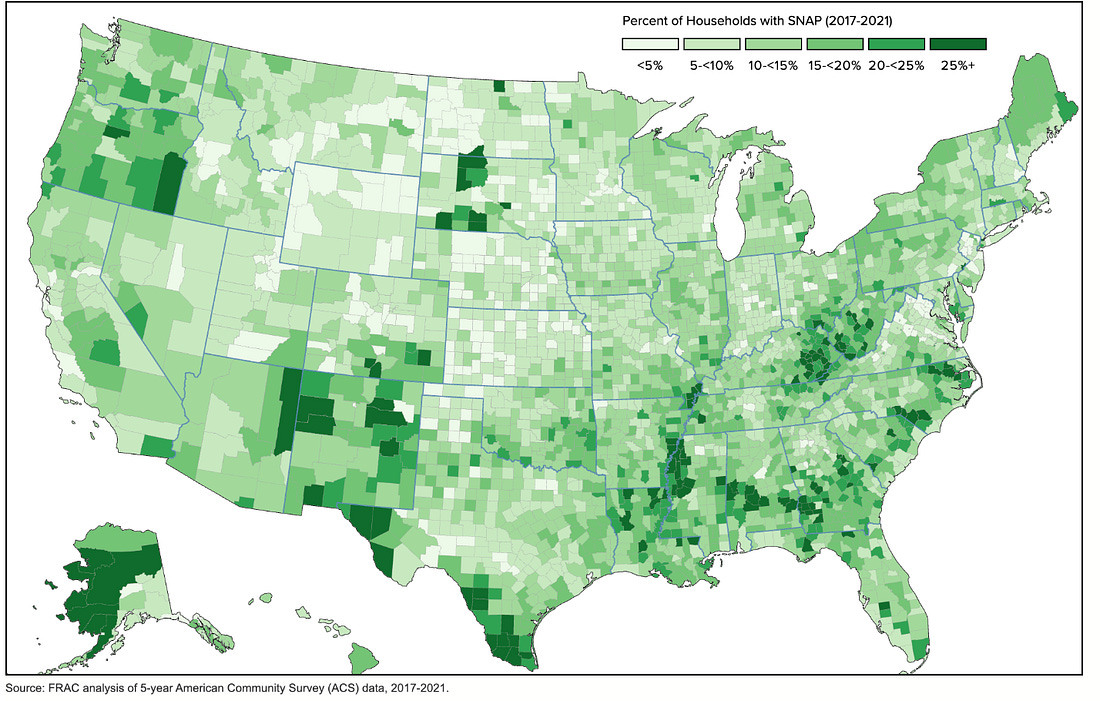| | |
The Hunger Games Begin
40 million Americans are about to lose food stamps
Source
There’s a bodega around the corner from my apartment where I often make small purchases, especially fruit, vegetables and bread. No, I’m not afraid to cross the street to buy bread.
While in in the check-out line, I often see some patrons, typically elderly and/or disabled, paying with EBT cards. EBT cards are the way the government delivers food aid under the Supplemental Nutritional Assistance Program, formerly known as food stamps. SNAP has become a crucial part of America’s social safety net, with more than 40 million Americans relying on those EBT cards to put food on the table.
And unless the government shutdown ends this week, which seems basically impossible, federal support for SNAP will be cut off this Saturday.
Here are four things you should know about the imminent hunger games.
This is a political decision — specifically, a Republican decision
Despite the government shutdown, the SNAP program isn’t out of money. In fact, it has $5 billion in contingency funds, intended as a reserve to be tapped in emergencies. And if the imminent cutoff of crucial food aid for 40 million people isn’t an emergency, what is? The Department of Agriculture, which runs the program, also has the ability to maintain funding for a while by shifting other funds around. But Donald Trump has — quite possibly illegally — told the department not to tap those funds.
Furthermore, the Republican majority in the Senate could maintain aid by waiving the filibuster on this issue. They have done this on other issues — for example, to roll back California’s electric vehicle standard. But for today’s Republican Party, blocking green energy is more important than keeping 40 million Americans from going hungry.
Furthermore, passing legislation to keep food aid flowing would require that Mike Johnson, the speaker, call the House back into session – something which he refuses to do. While we don’t know for sure the reason behind Johnson’s refusal, there is widespread speculation that it’s to avoid swearing in the newly elected Arizona congresswoman Adelina Grijalva, who would supply the crucial vote needed to force an overall vote on releasing the Epstein files. It sounds crazy to say that Republicans are making children go hungry to protect pedophiles, but it’s actually a reasonable interpretation of the situation.
The pain from lost food aid will, if anything, hurt Republican voters worse than Democrats
Republican strategy on the shutdown has rested on the premise that Democrats will eventually cave, based on several assumptions. First, G.O.P. strategists expected the public to blame Democrats for the impasse. Second, they thought that Democrats, who favor big government, would be anxious to resume federal spending. Lastly, I suspect that many Republicans simply assumed that SNAP beneficiaries are disproportionately Democrats.
So far, however, the shutdown impasse has developed not necessarily to the G.O.P.’s advantage. A plurality of Americans place more blame on Republicans than on Democrats. Moreover, given that Democrats have been more unified in their stance than the Republicans, it’s not at all obvious that Democrats will capitulate over the issue of reduced government spending.
What about the partisan affiliation of SNAP recipients? I’d be curious to see a survey of Republican legislators and activists on who they think the typical food aid recipient is. My bet is that they’re still under the influence of Ronald Reagan’s 1970s stereotypes, in which a “strapping young buck” buys T-bone steaks with food stamps. That is, MAGA probably views food stamps as a welfare program for urban nonwhites, including illegal immigrants.
Yet the evidence suggests that the program is most important to overwhelmingly white rural counties that strongly supported Trump. This is shown by the map at the top of this post, in which darker colors correspond to greater SNAP use.
Consider, for example, Owsley County in Kentucky. The county is 96 percent white, and last year it cast 88 percent of its votes for Trump. Also, 37 percent of residents are on SNAP.
So by refusing to maintain food aid, Republicans are hurting many of their own supporters.
The fact that Trump-supporting communities rely heavily on federal food aid raises another, even larger question: Why does the GOP want to cut food assistance generally? Apart from refusing to fund SNAP during the government shutdown, Republicans want to drastically cut back on food stamps over the long term. Indeed, savage cuts to SNAP are a key feature of the One Big Beautiful Bill passed earlier this year – cuts that were scheduled to happen after the midterm elections, not a few days from now.
Despite what Republicans believe, SNAP recipients aren’t malingerers
Why are Republicans hostile to a program that benefits tens of millions of Americans? Pay attention to right-wing rhetoric about food stamps and you’ll hear again and again assertions that SNAP beneficiaries are lazy malingerers — the “bums on welfare” who should be forced to go out and get jobs.
But that myth is punctured by a quick look at who gets SNAP. The fact is, the great majority of SNAP recipients can’t work: 40 percent are children; 18 percent are elderly; 11 percent are disabled. Furthermore, a majority of recipients who are capable of working do work. They are the working poor: their jobs just don’t pay enough, or offer sufficiently stable employment, to make ends meet without aid.
So efforts to force food stamp recipients to get jobs via work requirements or simply by cutting funding are doomed to failure. While it may be possible to push a handful of food stamp recipients into the labor force, any positive economic effects from such a push will be swamped by the negative effects of denying adequate nutrition and financial resources to children during a crucial part of their lives.
Food stamps are an investment in the future
Young children need adequate nutrition and in general need to grow up in households with adequate resources if they are to grow into healthy, productive adults.
In saying this I’m not making a vague assertion in line with liberal pieties. We have overwhelming empirical, statistical evidence that SNAP, by improving the lives of young children, is an extraordinarily effective way of investing in the future.
Where does this evidence come from? A pilot version of the modern food stamp program began in 1961, when an unemployed coal miner and his wife used food stamps to buy a can of pork and beans. The program was rolled out in earnest in 1964, as part of Lyndon Johnson’s War on Poverty. But the program didn’t immediately go into effect nationwide. Instead, it was gradually rolled out geographically over the course of a decade.
This gradual rollout provided a series of “natural experiments.” Economists can and have compared the life trajectories of Americans who, as children, benefited from food stamps with those of children with similar class and demographic characteristics whose families didn’t receive food aid.
The results are stunning. Children whose families received SNAP benefits grew up to become healthier, more productive adults than children whose families didn’t receive benefits. Spending money to help families with children is an extremely high-return investment in the nation’s future.
In fact, the evidence for large economic benefits from food stamps is far stronger than the evidence for payoffs from investment in physical infrastructure like roads, bridges and the power grid, although I favor those investments too. And the evidence that helping families with children is good for economic growth is infinitely better than the evidence for the efficacy of tax cuts for the rich, a central plank of conservative dogma — because there is no evidence that tax cuts boost growth.
Which brings us back to the impending cutoff of SNAP. It’s gratuitous: Republicans could easily avoid this cutoff if they wanted to. It’s cruel: Millions of Americans will suffer severely from the loss of food aid. And it’s destructive: Depriving children, in particular, of aid will cast a shadow on America’s economy and society for decades to come.
So of course the cutoff is going to happen. At this late date it’s hard to see how it can be avoided.
Substack.com |
|
|






